evolved over time to create
three newer haplotypes
Haplotype 1
that each differ by a few
C
A
T
C
A
T
nucleotides (red).
Haplotype 2
T
A
T
C
A
A
Haplotype 3
T
A
T
C
C
A
Haplotype 4
C
G
T
C
A
T
process can help us develop new strategies for
polymorphisms (abbreviated SNPs and profighting disease.
nounced “snips”).
For example, let’s say that a certain nucleotide
Clues from Variation
in one of your genes is A. In your uncle, however,
Scientists know quite a bit about how cells
the nucleotide in the same place on the same
reshuffle genetic information to create each pergene might be G. You and your uncle have slightly son’s unique genome. But many details are
different versions of that gene. Scientists call the
missing about how this genetic variation condifferent gene versions alleles.
tributes to disease, making for a very active area
If two genes sit right next to each other on a
of research.
chromosome, the SNPs in those genes tend to be
What scientists do know is that most of the
inherited together. This set of neighboring SNPs
human genome is the same in all of us. A little
is called a haplotype (see drawing above).
bit of genetic variation— differences that
Most chromosome regions have only a few,
account for much less than 1 percent of our
common haplotypes among all humans. As it
DNA — gives each of us a unique personality,
turns out, these few haplotypes — in different
appearance and health profile.
combinations in each person — appear to account
The parts of the human genome where the
for most of the variation from person to person
DNA sequences of many individuals vary by a
in a population.
single nucleotide are known as singlenucleotide
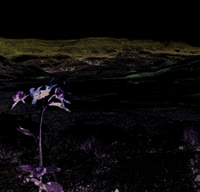
44 National Institute of General Medical Sciences Scientists can use haplotype information
to compare the genes of people affected by a
disease with those of unaffected people. For
example, this approach revealed a genetic variation that substantially increases the risk of agerelated macular degeneration, the leading
cause of severe vision loss in the elderly. Scientists
discovered that a single SNP — one nucleotide in
the 3 billionnucleotide human genome— makes
some people more likely to get this eye disease.
The discovery paves the way for better diagnostic
tests and treatments.
What about other diseases? In 2007, an
international scientific team completed a catalog
environments. He’s also curious about whether
of common human haplotypes. Since then,
it can create problems for some individuals.
researchers have been using the catalog to identify
You might be surprised to learn that
genes associated with susceptibility to many com
Rieseberg’s principal research subject is the sunmon diseases, including asthma, diabetes, cancer flower. Although many plants produce only one
and heart disease.
generation a year, plants like sunflowers can be
But not all SNPs are in genes. Scientists studyvery useful tools for researchers asking fundaing genetic variation have also found SNPs in mental questions about genetics. Because their
DNA that doesn’t encode proteins. Nonetheless,
genetic material is more malleable than that of
some of these SNPs appear to affect gene activity.
many animals, plants are excellent models for
Some researchers suspect that the “cryptic”
studying how evolution works.
(hidden) variation associated with SNPs in
Wild sunflowers appealed to Rieseberg
noncoding DNA plays an important role in
because there are several species that live in
determining the physical characteristics and
different habitats. Two ancient species of wild
behaviors of an organism.
sunflowers grow in moderate climates and are
Loren Rieseberg of Indiana University in
broadly distributed throughout the central and
Bloomington is one scientist who would love
western United States.
to take the mystery out of cryptic variation. He
Three recently evolved sunflower species live
wants to know how this noncoding genetic
in more specialized environments: One of the
variation can help organisms adapt to new
new species grows on sand dunes, another grows
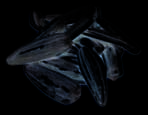

The New Genetics I Life’s Genetic Tree 45
in dry desert soil and the third species grows in
But when Rieseberg looked at the genomes
a salt marsh.
of his hybrid sunflowers, he was surprised to
To see how quickly new plant species could
find that they were just cutandpasted versions
evolve, Rieseberg forced the two ancient sunflowof the ancient sunflower species’ genomes: ers to interbreed with each other, something
large chunks had been
plants but not other organisms can do. Among
moved rather than many
the hybrid progeny were sunflowers that were just
new SNPs created.
like the three recently evolved species! What that
Rieseberg reasons
means is that Rieseberg had stimulated evolution
that plants stash away
in his lab, similar to what actually happened in
unused genetic material,
nature some 60,000 to 200,000 years ago, when
giving them a ready supply of
the newer species first arose.
ingredients they can use to adapt
That Rieseberg could do this is pretty amazquickly to a new environment. It may be that ing, but the really interesting part is how it
human genomes can recycle unused genetic
happened. Scientists generally assume that, for a
material to confront new challenges, as well.
new species with very different characteristics to
evolve, a lot of new mutations have to occur.
Plants like these sunflowers
make great models for studying how evolution works.
ALISON
DAVIS


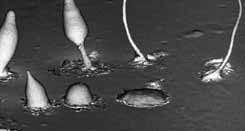

46 National Institute of General Medical Sciences 1
2
Living
REX L. CHISHOLM
Laboratories
Like most people, you probably think of fruit flies
Below is a sampling of the wide variety of
as kitchen nuisances. But did you know that sciliving laboratories that scientists are using to entists use these organisms for medical research?
advance human health.
Fruit flies and other model organisms — as
1 Escherichia coli: Bacterium different as mice, plants and zebrafish — permit
“Once we understand the biology of Escherichia scientists to investigate questions that would not
coli, we will understand the biology of an ele
be possible to study in any other way. These
phant.” So said Jacques Monod, a French scientist living systems are, relatively speaking, simple,
who won the 1965 Nobel Prize in physiology or
inexpensive and easy to work with.
medicine for his work on gene regulation. Monod
Model organisms are indispensable to science
was an early proponent of the value of experibecause creatures that appear very different from menting with simple organisms like bacteria. Are
us and from each other actually have a lot in
all bacteria bad? If all you’ve ever heard about E.
common when it comes to body chemistry. Even
coli is its notorious link to tainted hamburger
organisms that don’t have a body—mold and
meat, you may not realize that nondiseasecausing
yeast, for example—can give scientists clues to
strains of the bacterium live in the intestinal tracts
the workings of the tissues and organs of people.
of humans and other animals, helping them in a
This is because all living things process the
variety of ways. For one thing, these bacteria are
nutrients they consume into the same chemicals,
a main source of vitamin K and Bcomplex
more or less. The genes for the enzymes involved
vitamins. They also aid digestion and protect
in metabolism are similar in all organisms.
against infection by harmful bacteria.



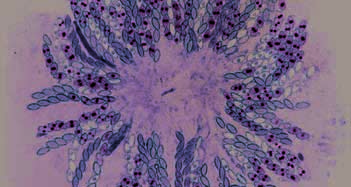
The New Genetics I Life’s Genetic Tree 47
3
NAMBOORI B. RAJU
Scientists all over the world have banded
Dicty normally grows as separate, independent
together to sequence different versions of the
cells. However, when food is limited, neighboring
E. coli genome. Among other things, these studies cells pile on top of each other to create a large,
will help distinguish the genetic differences
multicelled structure containing up to 100,000
between bacteria in a healthy human gut and
cells. This blob ambles along like a slug, leaving
those that cause food poisoning.
a trail of slime behind. After migrating to a more
suitable environment, the blob firms up into a
2 Dictyostelium discoideum: Amoeba towerlike structure that disperses spores, each
This microscopic amoeba—100,000 of them
capable of generating a new amoeba. Because of
form a mound as big as a grain of sand—is an
its unusual properties and ability to live alone or
important tool for health studies. Scientists have
in a group, Dicty intrigues researchers who study determined that Dictyostelium discoideum (Dicty) cell division, movement and various aspects of
has somewhere between 8,000 and 10,000 genes,
organ and tissue development.
many of which are close copies of those in people
and animals but are missing in another single
3 Neurospora crassa: Bread Mold celled organism, yeast. Dicty was first discovered Chances are you don’t think of a moldy bread
in the 1930s in a North Carolina forest and has
crust as a potential science experiment, but
since been found in many similar habitats around
thousands of researchers around the world do!
the world.
Neurospora crassa (Neurospora), which is a species of mold that thrives on bread, is a widely
used model organism for genetic research.

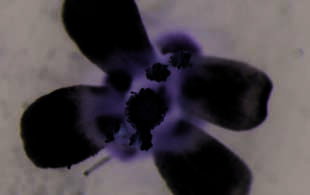
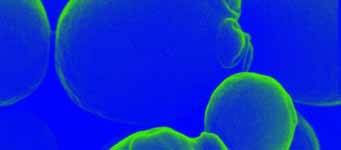
48 National Institute of General Medical Sciences 4
GARY DITTA
5
ALAN WHEALS
Biologists like to use Neurospora because
like yeast because it grows fast, is cheap to feed
it is simple to grow and has features that make
and safe to handle, and its genes are easy to work
it very suitable for answering questions about
with. We know a lot about mammalian genes
how species arise and adapt, as well as how cells
because scientists can easily insert them into yeast
and tissues change their shape in different
and then study how they work and what happens
environments. Since Neurospora produces spores
when they don’t work.
on a 24hour cycle, the organism is also useful
5 Arabidopsis thaliana: Mustard Plant for studying the biological clocks that govern
Researchers who study plant growth often use
sleep, wakefulness and other rhythms of life.
Arabidopsis thaliana (Arabidopsis), a small, 4 Saccharomyces cerevisiae: Yeast flowering plant related to cabbage and mustard.
There are hundreds of different kinds of yeast, but
This organism is appealing to biologists because
Saccharomyces cerevisiae, the one scientists study Arabidopsis has almost all of the same genes as
most often, is an important part of human life
other flowering plants and has relatively little
outside the lab, too. It is the yeast that bakers use
DNA that does not encode proteins, simplifying
to make bread and brewers use for beer.
the study of its genes. Like people and yeast,
Like Neurospora, yeast is actually a fungus—
plants are also eukaryotes. Arabidopsis grows
not a plant, not an animal, but related to both.
quickly, going from seed to mature plant in only
It is also a eukaryote (as is Neurospora)—a
6 weeks — another plus for researchers who study
“higher” organism with an organized, protective
how genes affect biology.
nucleus that holds its chromosomes. Researchers

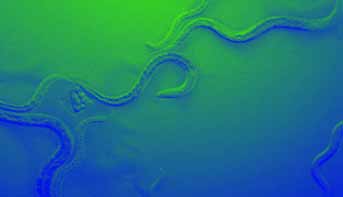

The New Genetics I Life’s Genetic Tree 49
6
7
What do you have in common with a mustard
has a lot of genes —more than 19,000 (humans
plant? Plant cells, and parts of plant cells, comhave about 20,000). Decoding the C. elegans municate with each other in much the same way
genome was a huge milestone for biology, since
that human cells do. For that reason, plants are
it was the first animal genome to be sequenced
good models for genetic diseases that affect
completely. Scientists quickly learned that a vast
cell communication.
number of genes in C. elegans are very similar to genes in other organisms, including people.
6 Caenorhabditis elegans: Roundworm Caenorhabditis elegans (C. elegans) is a creature 7 Drosophila melanogaster: Fruit Fly that is a lot smaller than its name! Several of
The fruit fly species most commonly used for
these harmless roundworms would fit on the
research is named Drosophila melanogaster
head of a pin, although their usual habitat is
(Drosophila). A geneticist’s fruit fly is pretty
dirt. In the lab, they live in petri dishes and eat
much the same as the ones that fly around your
bacteria. C. elegans contains just 959 cells, overripe bananas. In the lab, though, some of
almost a third of them forming its nervous
the flies are exposed to damaging chemicals or
system. Researchers know the fate of every one
radiation, which changes the sequence of their
of these cells!
DNA. Researchers allow the flies to mate, then
This worm is particularly prized by biologists
search among the offspring for flies with
because it is transparent, so what goes on in its
abnormalities. The mutant flies are then mated
tiny body is in plain view under a microscope.
to produce more offspring with the abnormality,
But for such a small, simple animal, C. elegans enabling researchers to close in on the defective
genes involved.

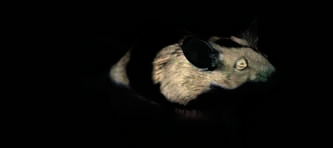
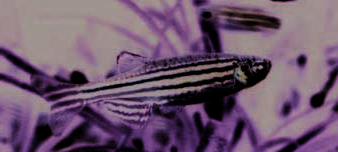
50 National Institute of General Medical Sciences 9
MONTE WESTERFIELD
8
Fruit flies have been a favorite experimental
Many researchers are drawn to zebrafish
organism among geneticists since early in the
because their eggs and embryos are transparent,
20th century. Hundreds of them can live in a
making it possible to watch development unfold.
pintsized milk bottle or even a small vial, and
In a span of 2 to 4 days, zebrafish cells split and
they reproduce so quickly that keeping track
form different parts of the baby fish’s body: eyes,
of a particular gene as it passes through a couple
heart, liver, stomach and so on. Sometimes,
of Drosophila generations takes only about a
researchers will move a cell to another spot to see
month. It’s also relatively easy to create flies with
if it will still go on to form the same part of the
mutations in many genes, enabling scientists to
body or if it will do something different. This
study how the genes work together.
research has taught scientists about a range of
healthrelated matters in people, including birth
8 Danio rerio: Zebrafish defects and the proper development of blood, the
Zebrafish were originally found in slow streams,
heart and the inner ear.
rice paddies and the Ganges River in East India
and Burma. They can also be found in most pet
9 Mus musculus: Mouse stores and are a home aquarium favorite.
The branches of life’s genetic tree that led eventu
Although the fish have been used by some
ally to mice and to human beings split off from
geneticists for research since the early 1970s, in
each other 75 million years ago, back in the
recent years they have become an especially
dinosaur age. But we are both mammals, and we
popular model organism.
share 85 percent of our genes. Because some
mouse diseases are very similar—sometimes

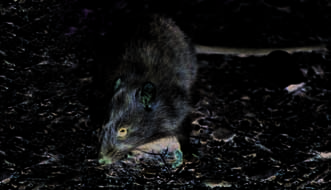


The New Genetics I Life’s Genetic Tree 51
10
identical—to human diseases, mice are
Although rats are mammals just like mice,
exceptionally valuable for research.
they differ in important ways. Rats are much
Since the late 1980s, researchers have been
bigger than mice, making it easier for scientists
able to engineer mice with missing genes.
to do experiments that involve the brain. For
Scientists make these “knockout” mice to learn
example, rats have taught scientists a lot about
what goes wrong when a particular gene is
substance abuse and addiction, learning, memory
removed. This gives them valuable clues about
and certain neurological diseases. Rats are also
the gene’s normal function. Identifying these
much better models than mice for studying
genes in humans has helped define the molecular
asthma and lung injury. And since, in people, the
basis for many illnesses.
disease arthritis is more common in women,
studying rats makes more sense because female
10 Rattus norvegicus: Rat rats appear to be more susceptible to arthritis
The Norway rat, or lab rat, was the first animal
than male rats. The opposite is true with mice.
domesticated for use in scientific research.
Currently, they make up about onefourth of all
research animals in the United States. Lab rats have
been used for many decades for testing drugs, and
much of what we know about cancercausing
This Living Laboratories section is
molecules was learned in basic research with rats.
available as a poster. To order a free copy,
visit http://publications.nigms.nih.gov/order.
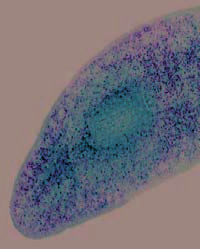
52 National Institute of General Medical Sciences The Genome Zoo
longer ago than the ancestor of humans and
Scientists often use an image of a tree to depict
chimpanzees, yet we still share hundreds of genes
how all organisms, living and extinct, are related
with bacteria.
to a common ancestor. In this “tree of life,” each
Scientists use the term comparative genomics
branch represents a species, and the forks bet




























